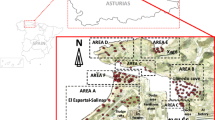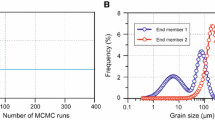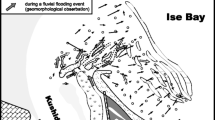Abstract
In part 2 of this contribution, examples are drawn from the River Mersey and Liverpool Bay illustrating the use of simple statistical parameters to describe dispersion of sands and muddy sediments. The River Mersey and Liverpool Bay, eastern Irish Sea, were sites of intensive studies on the dispersal of dumped harbour mud and sewage sludge during the mid 1960's–70's. The combined effects of strong tidal scour, wave action and shoreward near-bed residual drift result in shoreward transport of large volumes of sand in the bay. Large amounts of mud (silt/clay mixtures) oscillate in the river estuary, and naturally derived and dumped muds also move shoreward in the bay. Unpublished historic geochemical data have been combined with reprocessed particle size data and both have been used to reassess sedimentological techniques for defining transport and dispersal pathways. River and bay muds have similar size compositions, but river muds have excess Cd > V > U > As = Zn relative to bay muds. The lower relative concentrations of heavy metals in the bay are thought to reflect desorption and degradation of organic matter from the river. Trends in sediment distribution data based on the means of the sand size fraction, alone, provide sensitivities comparable to those of higher order moment measures and are usually easier to interpret than full size spectrum analyses.
Similar content being viewed by others
References
DSIR, 1938. Water pollution technical report # 7., HMSO., London.
Fernex, F. E., D. Span, G. N. Flatau & D. Renard, 1986. Behaviour of some metals in surficial sediments of the north west Mediterranean continental shelf. In Sediments and Water Interactions P. G. Sly (ed.). Springer-Verlag, New York: 353–370.
Förstner, U., W. Ahlf, W. Calmano, M. Kersten & W. Salomons, 1986. Mobility of heavy metals in dredged harbour sediments. In Sediments and Water Interactions P. G. Sly (ed.). Springer-Verlag, New York: 371–380.
Gornitz, V. & S. Lededeff, 1987. Global sea-level changs during the past century. In Sea-level fluctuation and coastal evolution Nummedal, D., O. H. Pilkey & J. D. Howard (eds). Special publ. #41, Soc. Econom. Palaeo. and Mineral., Tulsa, Oklahoma: 3–16.
Halliwell, A. R., 1973. Residual drift near the seabed in Liverpool Bay: an observational study. Geophys. J. Roy. Astro. Soc. 32: 439–458.
Halliwell, A. R. & B. O'Connor, 1965. Flow and siltation measurements in the River Mersey. J. Liverpool Engng. Soc., Liverpool, UK. XI (3): 21–45.
Hjulström, F., 1939. Transportation of detritus by moving water. In Recent Marine Sediments (Ed. P. D. Trask), Symp. Amer. Assoc. Petrol. Geol., Tulsa: 5–31.
Middleton, G. V., 1976. Hydraulic interpretation of sand size distributions. J. Geol. 84: 405–426.
Moore, J. R., 1968. Recent sedimentation in northern Cardigan Bay, Wales. Bull. British Museum (Nat. Hist.) Mineralogy Ser., London. 2: 21–131.
Sheng, P. Y. & W. Lick, 1979. The transport and resuspension of sediments in a shallow lake. J. Geophys. Res. 84: 1809–1826.
Sly, P. G., 1966. Marine geological studies in the eastern Irish Sea and adjacent estuaries, with special reference to sedimentation in Liverpool Bay and the River Mersey. PhD. Thesis, Dept. Geology, University of Liverpool, Liverpool, UK. 2v (297 pp and appendices).
Sly, P. G., 1984. Sedimentology and geochemistry of modern sediments in the Kingston basin of Lake Ontario. J. Great Lakes Res. 10: 358–374.
Sly, P. G., 1988. Sediment dispersion: Part I, fine sediments and significance of the silt/clay ratio. (this volume)
Sly, P. G., R. L. Thomas & B. R. Pelletier, 1983. Interpretation of moment measures derived from water-lain sediments. Sedimentol. 30: 219–233.
Thomas, R. L., 1972. The distribution of mercury in the sediments of Lake Ontario. Can. J. Earth Sci. 9: 636–651.
UKDOE, 1972. Out of sight out of mind. Report of a working party on the disposal of sludge in Liverpool Bay. UK Dept. of Environ., HMSO., London. 2v (36 pp and 485 pp).
Walker, R. G. (ed.), 1984. Facies models. Geoscience Canada Report Ser. 1., Geol. Assoc. Can. 377 pp.
Author information
Authors and Affiliations
Rights and permissions
About this article
Cite this article
Sly, P.G. Sediment dispersion: part 2, characterisation by size of sand fraction and percent mud. Hydrobiologia 176, 111–124 (1989). https://doi.org/10.1007/BF00026548
Issue Date:
DOI: https://doi.org/10.1007/BF00026548




